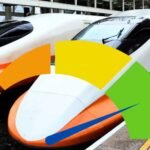Public transportation plays a crucial role in shaping the dynamics of urban Mobility, providing a sustainable and efficient means of transportation for millions of people worldwide. This comprehensive exploration delves into the fundamental principles, key components, recent innovations, notable applications, and the transformative impact of public transportation on cities and the environment.
Understanding Public Transportation
Public transportation refers to a system of vehicles, typically buses, trains, subways, and trams, operated by a public or private entity to transport passengers within a specific area. Unlike private vehicles, public transportation is shared among multiple passengers, offering an affordable and environmentally friendly alternative to individual car ownership.
Modes of Public Transportation
Public transportation encompasses various modes, each serving specific needs and preferences:
- Bus Transit: Buses are a versatile and widely used mode of public transportation, providing flexible routes and accessibility to diverse urban and suburban areas.
- Rail Systems: Trains, subways, and light rail systems offer efficient and rapid transit options, particularly in densely populated urban areas. They are known for their speed and capacity to move large numbers of passengers.
- BRT (Bus Rapid Transit): BRT systems combine the flexibility of buses with the efficiency of rail systems, featuring dedicated lanes and streamlined routes to enhance speed and reliability.
- Ferries and Water Taxis: In waterfront cities, ferries and water taxis provide a unique and scenic mode of public transportation, connecting different parts of the city across water bodies.
Key Components of Public Transportation
The effectiveness of public transportation systems relies on several key components working in harmony:
- Infrastructure: Public transportation includes bus stops, train stations, and transit hubs strategically placed to serve various neighborhoods and facilitate seamless transfers between different modes.
- Fleet of Vehicles: The fleet of public vehicles, whether buses, trains, or ferries, is a critical component. Regular maintenance and modernization of the fleet contribute to reliability and passenger comfort.
- Scheduling and Routing: Efficient scheduling and well-designed routes ensure that public transportation meets the demands of different communities. Real-time updates and dynamic routing contribute to adaptability in response to changing urban dynamics.
Recent Innovations in Public Transportation
Recent innovations have transformed public transportation, making it more accessible, efficient, and environmentally friendly:
Digital Ticketing and Payment Systems
Integrating digital ticketing and payment systems has streamlined the boarding process, reducing wait times and making public transportation more user-friendly. Contactless payment options and mobile apps contribute to a seamless passenger experience.
Real-Time Tracking and Communication
Real-time tracking systems and communication platforms provide passengers with up-to-date information on arrival times, delays, and alternative routes. This technology enhances transparency and improves the overall reliability of public transportation.
Electric and Hybrid Vehicles
Adopting electric and hybrid vehicles in public transportation fleets contributes to environmental sustainability by reducing emissions and dependence on fossil fuels. These eco-friendly alternatives align with global efforts to combat climate change.
Integration with Ride-Sharing and Micro-Mobility
Public transportation systems are increasingly integrating with ride-sharing services and micro-mobility options such as bikes and scooters. This integrated approach offers passengers flexible and comprehensive transportation solutions for their entire journey.
Notable Applications of Public Transportation
Public transportation extends its impact beyond moving people from one point to another, influencing various aspects of urban life:
Traffic Congestion Reduction
Public transportation helps alleviate traffic congestion in urban areas by providing an alternative to individual car use. Well-designed systems encourage more people to opt for shared transportation, reducing the number of vehicles on the road.
Accessibility and Inclusivity
Public transportation promotes accessibility for diverse demographics, including individuals with disabilities and those who cannot afford private vehicles. Accessible infrastructure and services ensure that public transportation is inclusive and available.
Economic Benefits
Investments in public transportation infrastructure stimulate economic growth by creating jobs, fostering local businesses around transit hubs, and improving property values. A robust public transportation system contributes to a city’s overall economic vitality.
Environmental Sustainability
Public transportation is a key player in promoting environmentally sustainable urban development. By reducing the carbon footprint associated with individual car travel, public transportation helps combat air pollution and climate change.
Challenges in Public Transportation
While public transportation offers numerous benefits, it faces challenges impacting its efficiency and widespread adoption:
Funding and Financial Viability
Public transportation systems often face financial challenges, relying on government subsidies and fare revenue. Securing consistent funding for infrastructure maintenance, upgrades, and expansions is crucial for the long-term viability of public transportation.
Last-Mile Connectivity
The challenge of last-mile connectivity refers to some passengers’ difficulty in reaching their final destinations from transit stops. Integrating with micro-mobility options and improving first- and last-mile connectivity remains challenging in some urban areas.
Safety and Security Concerns
Ensuring the safety and security of passengers using public transportation is a priority. Addressing concerns related to crime, accidents, and passenger well-being requires ongoing efforts in surveillance, personnel training, and community engagement.
Future Trends in Public Transportation
As technology continues to advance, the future of public transportation promises exciting trends that will further redefine its capabilities and applications:
Autonomous Public Transportation
The integration of autonomous vehicles into public transportation fleets represents a future trend. Autonomous buses and shuttles have the potential to enhance efficiency, reduce operating costs, and improve the overall safety of public transportation.
Sustainable Infrastructure and Design
Future public transportation projects will likely focus on sustainable and eco-friendly infrastructure. Green roofs, solar panels, and energy-efficient designs aim to reduce transit facilities’ environmental impact.
Mobility as a Service (MaaS) Integration
Integrating Mobility as a Service (MaaS) platforms will provide passengers with seamless transportation experiences. MaaS allows users to plan, book, and pay for various modes of transportation through a single digital platform.
Hyperloop and High-Speed Rail
Hyperloop technology and high-speed rail projects represent futuristic modes of public transportation. These innovations aim to revolutionize long-distance travel, making it faster and more efficient.
Conclusion
Public transportation stands as the backbone of urban Mobility, offering a sustainable and efficient alternative to private vehicle ownership. From reducing traffic congestion to promoting economic growth and environmental sustainability, the impact of public transportation extends far beyond its primary function. Despite challenges, ongoing innovations in technology, infrastructure, and service integration signal a promising future for public transportation. As research and development continue to push the boundaries of what is possible, public transportation remains a cornerstone in creating more livable, connected, and sustainable cities worldwide.










